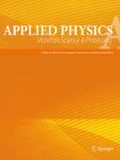Abstract
The 3D bioplotter, which is one of the rapid-prototyping systems, enables us to produce the design-based scaffolds which could control good mechanical properties and pore structures for mimicking human organs. Although the plotting system has several advantages to fabricate a variety of designed scaffolds, the main disadvantage of scaffolds fabricated by the system is that the strand surfaces are too smooth and tend to discourage initial cell attachment within the scaffolds. To overcome the problem, we suggest a new 3D plotting method supplemented by piezoelectric vibration system for fabricating scaffolds that have hierarchical surface structures, which increase the surface roughness of the scaffold without any additional chemical process. The surface-modified 3D scaffold exhibited various positive qualities including enhanced compressive modulus and improved initial cell attachment and proliferation. Cell culturing results demonstrated that the interactions between chondrocytes and the scaffold were much more favorable than those between the cells and conventionally plotted 3D scaffolds. This process provides a feasible new technique for fabricating high-quality 3D scaffolds for tissue engineering applications.
Similar content being viewed by others
References
C.J. Buckley, K.U. O’Kelly, Regular scaffold fabrication technique for investigations in tissue engineering, in Topics in Bio-Mechanical Engineering, ed. by P.J. Prendergast, P.E. McHugh (Trinity Centre for Bioengineering, Dublin, 2004), pp. 147–166
K.C. Shin, B.S. Kim, J.H. Kim, T.G. Park, J.D. Nam, D.S. Lee, Polymer 46, 3801 (2005)
M. Mathieu, T.L. Mueller, P.-E. Bourban, D.P. Pioletti, R. Muller, J.A.E. Manson, Biomaterials 27, 905 (2006)
S. Oh, S.G. Kang, E.S. Kim, S.H. Cho, J.H. Lee, Biomaterials 24, 4011 (2003)
K. Whang, C.H. Thomas, K.E. Healy, Polymer 36, 837 (1995)
W.-Y. Yeong, C.-K. Chua, K.-F. Leong, M. Chandrasekaran, Trends Biotech. 22, 643–652 (2004)
E. Sachlos, J.T. Czernuszka, Eur. Cells Mater. 5, 29–40 (2003)
D.W. Hutmacher, Biomaterials 21, 2529 (2000)
D.W. Hutmacher, M. Sittinger, M.V. Risbud, Trends Biotech. 22, 354–362 (2004)
R. Landers, A. Pfister, U. Hubner, H. John, R. Schmelzeisen, R. Mulhaupt, J. Mater. Sci. 37, 3107 (2002)
R. Landers, U. Hübner, R. Schmelzeisen, Biomaterials 23, 4437–4447 (2002)
S.G. Hollister, R.D. Maddox, J.M. Taboas, Biomaterials 23, 4095 (2002)
S.J. Hollister, Nat. Mater. 4, 518–524 (2005)
R. Mülhaupt, R. Landers, Y. Thomann, Eur. Cells Mater. 6 (Suppl. 1) (2003)
B.F. Woodfield, J. Malda, J. de Wijn, F. Péters, J. Riesle, C.A. van Blitterswijk, Biomaterials 25, 4149–4161 (2004)
A. Thapa, D.C. Miller, T.J. Webster, K.M. Haberstroh, Biomaterials 24, 2915–2926 (2003)
Y. Wan, Y. Wang, Z. Liu, X. Qu, B. Han, J. Bei, S. Wang, Biomaterials 26, 4453 (2005)
C.C. Berry, G. Campbell, A. Spadiccino, M. Robertson, A. Curtis, Biomaterials 25, 5781 (2004)
Author information
Authors and Affiliations
Corresponding author
Rights and permissions
About this article
Cite this article
Kim, G.H., Son, J.G. 3D polycarprolactone (PCL) scaffold with hierarchical structure fabricated by a piezoelectric transducer (PZT)-assisted bioplotter. Appl. Phys. A 94, 781–785 (2009). https://doi.org/10.1007/s00339-008-4959-3
Received:
Accepted:
Published:
Issue Date:
DOI: https://doi.org/10.1007/s00339-008-4959-3


